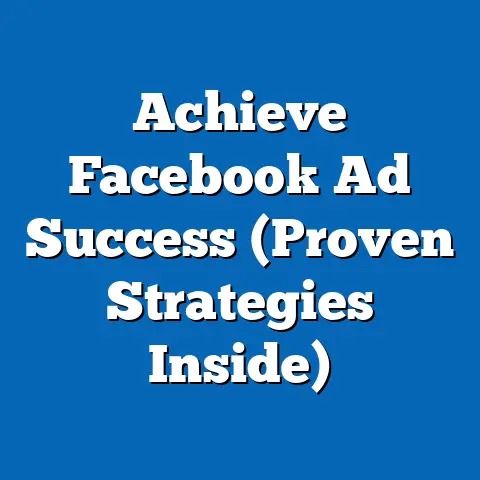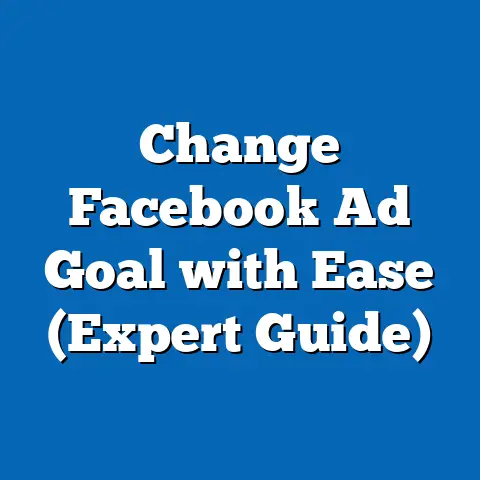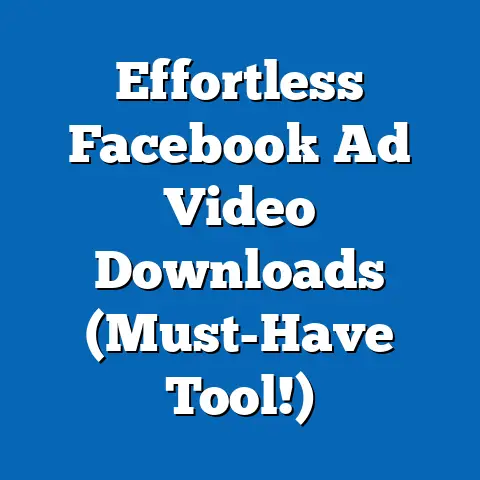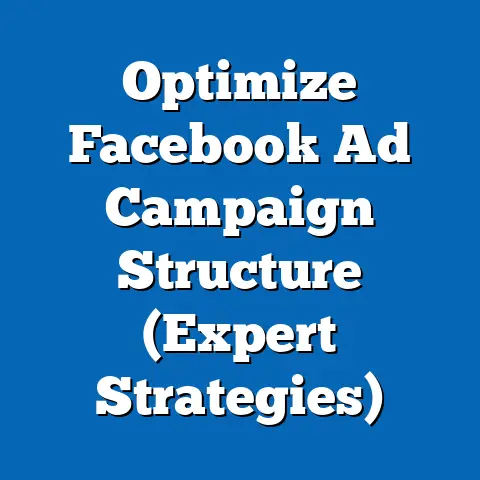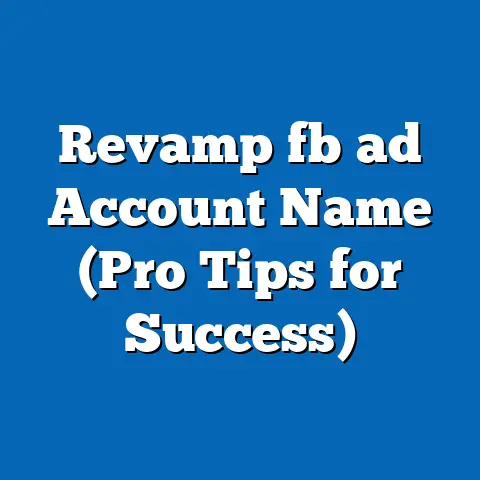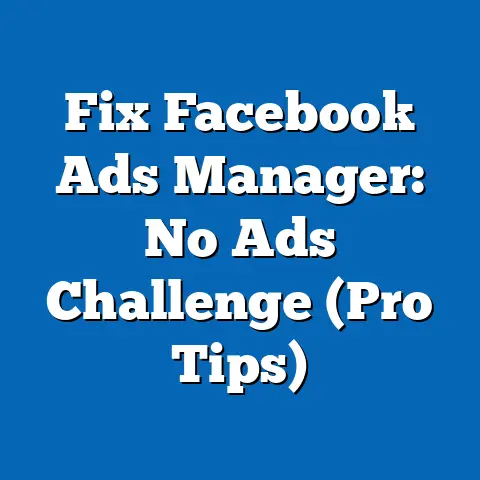Mastering Storytelling in Facebook Ads (Proven Strategies)
The digital world is a cacophony. A constant barrage of information, notifications, and, of course, ads. As marketers, we’re all fighting for a sliver of attention in this noisy landscape. We’re throwing money at Facebook, crafting catchy headlines, and designing eye-catching visuals, but often, it feels like our messages are just getting lost in the shuffle. I’ve been there, staring at disappointing campaign results, wondering where I went wrong. The truth is, consumers are becoming increasingly immune to traditional advertising. They’re tired of being sold to; they crave connection, authenticity, and something that resonates with them on a deeper level.
I remember one campaign in particular. We were launching a new line of organic skincare products, and I thought I had it all figured out. Stunning product shots, benefit-driven copy, and precise targeting. Yet, the results were underwhelming. Clicks were low, conversions were even lower. It was then that I realized I was missing a crucial ingredient: a story. I wasn’t just selling skincare; I was selling confidence, self-care, and a journey towards healthier skin.
According to a recent study by Nielsen, consumers are 55% more likely to remember a brand that tells a compelling story. Think about that for a moment. More than half of your potential customers are more likely to remember you, not because of your product features, but because of the story you tell. This is where the power of storytelling comes in. It’s not just about selling a product; it’s about creating a connection, building trust, and leaving a lasting impression.
In this article, I’m going to dive deep into the world of storytelling in Facebook ads. I’ll share proven strategies, real-world examples, and actionable tips that you can use to transform your ads from mundane promotional messages into compelling narratives that captivate your audience and drive conversions. We’ll explore the psychological aspects of storytelling, the key elements of a great story, how to craft your brand’s unique narrative, and how to measure the success of your storytelling efforts. By the end of this guide, you’ll be equipped with the knowledge and tools you need to master the art of storytelling in Facebook ads and unlock a whole new level of engagement and results. So, let’s get started!
Section 1: Understanding the Power of Storytelling
What is Storytelling in Advertising?
Storytelling in advertising is more than just creating a narrative around your product or service. It’s about crafting a compelling and authentic connection with your audience by sharing experiences, values, and emotions that resonate with them. It involves weaving a narrative that captures attention, holds interest, and ultimately drives action.
Think of it this way: traditional advertising is like shouting your message from a rooftop, hoping someone will hear you. Storytelling advertising, on the other hand, is like inviting someone into your living room, sharing a cup of coffee, and engaging in a meaningful conversation.
I’ve seen firsthand how this shift in perspective can revolutionize a campaign. I once worked with a local coffee shop that was struggling to compete with larger chains. Instead of focusing on price or convenience, we decided to tell the story of their coffee. We created a series of Facebook ads that showcased the journey of their beans, from the small, family-owned farms where they were grown to the meticulous roasting process that brought out their unique flavors. We highlighted the passion and dedication of the people behind the coffee, creating a narrative that resonated with customers who valued quality and authenticity. The result? A significant increase in foot traffic and a loyal customer base.
The Psychology Behind Storytelling
Why are humans so drawn to stories? The answer lies in our brains. Research has shown that stories activate multiple areas of the brain, including those responsible for emotions, empathy, and memory. When we hear a story, we don’t just passively receive information; we actively participate in the narrative, imagining ourselves in the characters’ shoes and experiencing their emotions.
Here’s a breakdown of the key psychological aspects:
- Emotional Connection: Stories evoke emotions, and emotions drive decisions. When we feel connected to a character or situation, we’re more likely to remember the story and the brand associated with it.
- Relatability: Stories that reflect our own experiences, values, or aspirations are more likely to resonate with us. We connect with characters who face similar challenges or share similar goals.
- Memorability: Stories are easier to remember than facts and figures. They provide context and meaning, making information more engaging and memorable.
- Empathy: Stories allow us to step into someone else’s shoes and experience the world from their perspective. This fosters empathy and understanding, which can strengthen our connection to the brand.
Examples of Brands Using Storytelling Effectively
Numerous brands have successfully leveraged the power of storytelling in their advertising campaigns. Here are a few notable examples:
- Dove’s “Real Beauty” Campaign: Dove’s campaign challenged conventional beauty standards by showcasing diverse women and celebrating their natural beauty. The campaign resonated with millions of women around the world, creating a powerful emotional connection and reinforcing Dove’s brand values. I remember when this campaign first launched, the conversations it sparked were incredible. It wasn’t just about selling soap; it was about empowering women and changing the way we think about beauty.
- Always’ “Like a Girl” Campaign: Always’ campaign tackled the negative connotations associated with the phrase “like a girl,” encouraging girls to embrace their strength and confidence. The campaign sparked a global conversation and empowered young girls to defy stereotypes. This is a great example of how storytelling can be used to address social issues and create positive change.
- Airbnb’s “Belong Anywhere” Campaign: Airbnb’s campaign focused on the human connection and cultural immersion that comes with traveling and staying in local homes. The campaign told stories of travelers who had unique and transformative experiences through Airbnb, highlighting the brand’s commitment to creating a sense of belonging. I’ve personally used Airbnb on several trips, and I can attest to the power of their storytelling. It’s not just about finding a place to stay; it’s about connecting with local cultures and creating unforgettable memories.
Traditional vs. Storytelling Advertising: A Key Difference
The key difference between traditional advertising and storytelling advertising lies in the focus. Traditional advertising focuses on features, benefits, and price points. It’s about telling people why they should buy your product. Storytelling advertising, on the other hand, focuses on creating a connection, building trust, and inspiring action. It’s about showing people how your product can help them achieve their goals, solve their problems, or live a better life.
| Feature | Traditional Advertising | Storytelling Advertising |
|---|---|---|
| Focus | Features, benefits, price | Connection, trust, inspiration |
| Message | “Buy our product because it’s the best.” | “Our product can help you achieve your dreams.” |
| Approach | Informative, direct | Emotional, engaging |
| Goal | Sell products | Build relationships, create brand loyalty |
| Customer Role | Passive recipient of information | Active participant in the narrative |
| Feature | Traditional Advertising | Storytelling Advertising |
|---|---|---|
| Focus | Features, benefits, price | Connection, trust, inspiration |
| Message | “Buy our product because it’s the best.” | “Our product can help you achieve your dreams.” |
| Approach | Informative, direct | Emotional, engaging |
| Goal | Sell products | Build relationships, create brand loyalty |
| Customer Role | Passive recipient of information | Active participant in the narrative |
Key Takeaway: Storytelling in advertising is about connecting with your audience on an emotional level, building trust, and inspiring action. It’s about crafting a narrative that captures attention, holds interest, and leaves a lasting impression.
Next Steps: Reflect on your current advertising strategy. Are you focusing on features and benefits, or are you telling a story that resonates with your audience? Consider how you can incorporate storytelling into your next campaign to create a more meaningful connection with your customers.
Section 2: Key Elements of a Great Story
Now that we understand the power of storytelling, let’s dive into the key elements that make a great story. Whether you’re writing a novel, creating a film, or crafting a Facebook ad, these core components are essential for capturing attention, holding interest, and leaving a lasting impression.
Character: The Heart of the Story
Every great story needs a compelling character. This is the person (or sometimes, the animal or object) that the audience connects with and roots for. In the context of advertising, your character is often a representation of your target audience – a customer persona that embodies their hopes, dreams, and challenges.
Why is character so important?
- Relatability: Audiences need to see themselves in the character. They need to understand their motivations, empathize with their struggles, and celebrate their successes.
- Connection: A well-developed character creates an emotional connection with the audience. We care about what happens to them, and we’re invested in their journey.
- Memorability: Characters are often the most memorable part of a story. We remember their names, their quirks, and their impact on the narrative.
Creating a Compelling Character:
- Understand Your Audience: Start by deeply understanding your target audience. What are their demographics, interests, pain points, and aspirations?
- Develop a Persona: Create a detailed persona that represents your ideal customer. Give them a name, a backstory, and a clear set of motivations.
- Make Them Relatable: Ensure that your character faces challenges that your audience can relate to. Show their vulnerabilities and their strengths.
I remember working with a local bakery that wanted to promote their new line of gluten-free pastries. Instead of simply showcasing the pastries, we created a character named Sarah, a busy mom who struggled to find delicious and convenient gluten-free options for her family. We followed Sarah’s journey as she discovered the bakery’s pastries, highlighting the joy and relief she felt in finding a solution to her problem. By focusing on Sarah’s character and her relatable struggles, we created a campaign that resonated with other busy moms who were looking for gluten-free options.
Conflict: The Driving Force
Conflict is the engine that drives the story forward. It’s the challenge, the problem, or the obstacle that the character must overcome. Without conflict, there’s no story.
Why is conflict so important?
- Creates Tension: Conflict creates tension and keeps the audience engaged. We want to know how the character will overcome the challenge.
- Highlights the Stakes: Conflict highlights the stakes of the story. We understand what the character stands to lose or gain, which makes us more invested in their journey.
- Demonstrates Value: Conflict provides an opportunity to demonstrate the value of your product or service. You can show how it helps the character overcome their challenges and achieve their goals.
Types of Conflict:
- Internal Conflict: A struggle within the character’s own mind or heart.
- External Conflict: A struggle against an outside force, such as another character, a natural disaster, or a societal problem.
Using Conflict in Facebook Ads:
- Identify Your Audience’s Pain Points: What are the biggest challenges that your target audience faces?
- Present a Problem: Introduce a problem that resonates with your audience’s pain points.
- Create Tension: Build tension by highlighting the consequences of not solving the problem.
For example, a financial planning company might create a Facebook ad that presents the conflict of being unprepared for retirement. The ad could show a character struggling to make ends meet in their later years, highlighting the consequences of not planning ahead.
Resolution: The Satisfying Conclusion
The resolution is the point in the story where the conflict is resolved, and the character achieves their goal. It’s the satisfying conclusion that leaves the audience feeling fulfilled and inspired.
Why is resolution so important?
- Provides Closure: Resolution provides closure and satisfies the audience’s desire for a happy ending.
- Reinforces Value: Resolution reinforces the value of your product or service. It shows how it helped the character overcome their challenges and achieve their goals.
- Inspires Action: A well-executed resolution can inspire the audience to take action. They see how your product can improve their lives, and they’re motivated to try it for themselves.
Crafting a Compelling Resolution:
- Show, Don’t Tell: Show how your product helped the character overcome their challenges. Don’t just tell the audience that it works.
- Make it Believable: The resolution should be believable and realistic. It should feel like a natural outcome of the character’s journey.
- Highlight the Benefits: Emphasize the positive outcomes of the resolution. Show how the character’s life has improved as a result of using your product.
Returning to the example of the financial planning company, the resolution could show the character enjoying a comfortable and fulfilling retirement, thanks to the company’s financial planning services. The ad could highlight the benefits of planning ahead, such as peace of mind, financial security, and the ability to pursue passions in retirement.
Emotion: The Secret Ingredient
Emotion is the secret ingredient that brings the story to life. It’s the feeling that resonates with the audience and creates a lasting impact.
Why is emotion so important?
- Creates Connection: Emotions create a deep connection with the audience. We’re more likely to remember stories that make us feel something.
- Drives Action: Emotions drive decisions. When we feel strongly about something, we’re more likely to take action.
- Enhances Memorability: Emotional stories are more memorable than factual stories. They stick with us long after we’ve heard them.
Types of Emotions:
- Positive Emotions: Joy, happiness, excitement, hope, inspiration.
- Negative Emotions: Sadness, fear, anger, frustration, anxiety.
Using Emotion in Facebook Ads:
- Understand Your Audience’s Emotions: What emotions are most relevant to your target audience’s pain points and aspirations?
- Evoke Emotion with Visuals: Use images and videos that evoke the desired emotions.
- Craft Emotional Copy: Write copy that speaks to your audience’s feelings and aspirations.
I once worked with a local animal shelter that wanted to increase adoption rates. Instead of simply showing pictures of the animals, we created a series of Facebook ads that told their stories. We highlighted the animals’ personalities, their struggles, and their hopes for a better life. We used emotional visuals and heartfelt copy to evoke empathy and compassion in the audience. The result? A significant increase in adoption rates and a surge of donations.
Key Takeaway: A great story needs a compelling character, a driving conflict, a satisfying resolution, and a healthy dose of emotion. By incorporating these elements into your Facebook ads, you can create narratives that capture attention, hold interest, and inspire action.
Next Steps: Analyze your existing Facebook ads. Do they incorporate these key elements of storytelling? Consider how you can revise your ads to create a more compelling and emotional narrative.
Section 3: Crafting Your Brand’s Story
Now that we understand the key elements of a great story, let’s focus on crafting your brand’s unique narrative. This is about defining your brand’s purpose, values, and personality, and then weaving them into a compelling story that resonates with your target audience.
Understanding Your Brand’s Mission and Values
Before you can tell your brand’s story, you need to understand what your brand stands for. What is your mission? What are your core values? What makes your brand unique?
Here’s a step-by-step process for defining your brand’s mission and values:
- Reflect on Your Purpose: Why does your brand exist? What problem are you trying to solve? What impact do you want to make on the world?
- Identify Your Core Values: What principles guide your brand’s actions and decisions? What do you believe in?
- Define Your Brand Personality: If your brand were a person, what would they be like? What would their personality traits be?
I remember when I first started my own marketing agency, I struggled to define my brand’s mission and values. I knew I wanted to help businesses grow, but I didn’t have a clear sense of what made my agency unique. After some soul-searching, I realized that my passion was for helping small, local businesses thrive. I believed in the power of community and the importance of supporting local economies. This became the foundation of my brand’s mission and values.
Identifying Your Target Audience and Their Pain Points
Once you understand your brand’s mission and values, you need to identify your target audience and their pain points. This is about understanding who you’re trying to reach and what challenges they face.
Here’s how to identify your target audience and their pain points:
- Create Customer Personas: Develop detailed personas that represent your ideal customers. Give them names, backstories, and clear sets of motivations and challenges.
- Conduct Market Research: Conduct surveys, interviews, and focus groups to gather insights into your target audience’s needs, desires, and pain points.
- Analyze Your Existing Customer Data: Review your customer data to identify patterns and trends. What are your customers buying? What problems are they trying to solve?
Creating a Unique Selling Proposition (USP) That Aligns with Your Story
Your Unique Selling Proposition (USP) is what sets your brand apart from the competition. It’s the reason why customers should choose you over everyone else. Your USP should be clear, concise, and compelling, and it should align with your brand’s story.
Here’s how to create a USP that aligns with your story:
- Identify Your Strengths: What are your brand’s unique strengths and capabilities? What do you do better than anyone else?
- Focus on Benefits, Not Features: Instead of focusing on the features of your product or service, focus on the benefits that it provides to your customers.
- Make it Believable: Your USP should be believable and realistic. It should feel like a natural extension of your brand’s story.
For example, let’s say you own a local bakery that specializes in organic, gluten-free bread. Your USP could be: “We bake delicious, organic, gluten-free bread that nourishes your body and supports local farmers.” This USP is clear, concise, and compelling, and it aligns with the brand’s story of providing healthy and sustainable food options.
Gathering Customer Stories and Testimonials to Enhance Authenticity
One of the most powerful ways to enhance the authenticity of your brand’s story is to gather customer stories and testimonials. These are real-life accounts of how your product or service has helped your customers achieve their goals, solve their problems, or live a better life.
Here’s how to gather customer stories and testimonials:
- Ask Your Customers: Simply ask your customers if they’re willing to share their stories. You can do this through email, social media, or in-person.
- Offer Incentives: Offer incentives, such as discounts or free products, to encourage customers to share their stories.
- Make it Easy: Make it easy for customers to share their stories. Provide them with a template or a set of questions to guide their responses.
I’ve found that the most compelling customer stories are often the ones that are the most authentic and unscripted. Don’t try to force your customers to say what you want them to say. Let them speak from the heart and share their genuine experiences.
Key Takeaway: Crafting your brand’s story is about defining your brand’s purpose, values, and personality, and then weaving them into a compelling narrative that resonates with your target audience. By understanding your brand, your audience, and your USP, you can create a story that sets you apart from the competition and builds a loyal customer base.
Next Steps: Take some time to reflect on your brand’s mission, values, and personality. Identify your target audience and their pain points. Craft a USP that aligns with your story. Gather customer stories and testimonials to enhance authenticity.
Section 4: Techniques for Implementing Storytelling in Facebook Ads
Now that we’ve laid the foundation for crafting your brand’s story, let’s explore some specific techniques for implementing storytelling in your Facebook ads.
Using Video Content to Tell a More Immersive Story
Video content is one of the most powerful tools for telling a more immersive story in your Facebook ads. Videos can capture attention, evoke emotions, and convey complex information in a way that static images and text simply can’t.
Here are some tips for using video content to tell a compelling story:
- Focus on Emotion: Use visuals, music, and narration to evoke the desired emotions in your audience.
- Keep it Short and Sweet: Attention spans are short on social media. Aim for videos that are 15-30 seconds long.
- Optimize for Mobile: Most Facebook users are on mobile devices. Make sure your videos are optimized for mobile viewing.
- Tell a Story, Don’t Just Sell: Focus on telling a story that resonates with your audience, rather than simply showcasing your product or service.
I’ve seen firsthand how effective video content can be in Facebook ads. I once worked with a local brewery that wanted to promote their new seasonal beer. Instead of simply showing a picture of the beer, we created a short video that told the story of the beer’s ingredients, from the local hops to the pure mountain water. We showed the brewers crafting the beer with passion and dedication. The video captured the essence of the beer and the brewery’s commitment to quality. The result? A significant increase in sales and a surge of positive feedback.
Crafting Ad Copy That Focuses on Narrative Rather Than Features
Your ad copy is just as important as your visuals when it comes to telling a compelling story. Instead of focusing on the features of your product or service, focus on the narrative and the benefits that it provides to your customers.
Here are some tips for crafting ad copy that focuses on narrative:
- Start with a Hook: Grab your audience’s attention with a compelling opening line.
- Tell a Story: Use your ad copy to tell a story that resonates with your audience’s pain points and aspirations.
- Focus on Benefits: Highlight the benefits that your product or service provides to your customers.
- Use Emotion: Evoke the desired emotions in your audience with your words.
- End with a Call to Action: Tell your audience what you want them to do next.
For example, instead of writing “Our new software has advanced features and a user-friendly interface,” you could write “Imagine a world where you can effortlessly manage your projects and collaborate with your team. Our new software makes it possible.” This copy focuses on the narrative and the benefits, rather than the features.
Utilizing Carousel Ads to Unfold a Story Across Multiple Frames
Carousel ads allow you to showcase multiple images or videos in a single ad unit. This is a great way to unfold a story across multiple frames and keep your audience engaged.
Here are some tips for using carousel ads to tell a story:
- Create a Sequence: Arrange your images or videos in a sequence that tells a story.
- Use Captions: Use captions to provide context and guide your audience through the story.
- Focus on a Single Theme: Each carousel card should focus on a single theme or aspect of the story.
- End with a Call to Action: End the carousel with a clear call to action that tells your audience what you want them to do next.
For example, a travel agency could use a carousel ad to tell the story of a couple’s dream vacation. Each card could showcase a different aspect of the vacation, such as the stunning scenery, the delicious food, and the unforgettable experiences.
Incorporating User-Generated Content to Convey Authenticity and Relatability
User-generated content (UGC) is content created by your customers, such as photos, videos, and reviews. Incorporating UGC into your Facebook ads is a great way to convey authenticity and relatability.
Here are some tips for incorporating UGC into your Facebook ads:
- Ask for Permission: Always ask for permission before using your customers’ content.
- Highlight Real People: Showcase real people using your product or service in their everyday lives.
- Use Authentic Voices: Let your customers speak for themselves. Don’t try to script or control their message.
- Focus on Benefits: Highlight the benefits that your customers have experienced as a result of using your product or service.
I’ve found that UGC is incredibly effective in building trust and credibility. When people see that other customers are happy with your product or service, they’re more likely to give it a try themselves.
Key Takeaway: There are many techniques you can use to implement storytelling in your Facebook ads. By using video content, crafting narrative-driven ad copy, utilizing carousel ads, and incorporating user-generated content, you can create ads that capture attention, hold interest, and inspire action.
Next Steps: Experiment with these techniques in your next Facebook ad campaign. Track your results and see which techniques resonate most with your audience.
Section 5: Measuring Success and Adjusting Your Strategy
So, you’ve crafted your brand’s story, implemented storytelling techniques in your Facebook ads, and launched your campaign. Now what? It’s time to measure your success and adjust your strategy based on the data.
The Importance of Analytics in Evaluating Storytelling Ads
Analytics are essential for evaluating the effectiveness of your storytelling ads. They provide insights into how your audience is responding to your narrative and whether your ads are achieving your desired results.
Here’s why analytics are so important:
- Track Performance: Analytics allow you to track the performance of your ads over time. You can see how many people are seeing your ads, clicking on them, and converting into customers.
- Identify Trends: Analytics help you identify trends in your audience’s behavior. You can see which ads are performing well, which ads are underperforming, and what types of content resonate most with your audience.
- Optimize Your Strategy: Analytics provide the data you need to optimize your strategy. You can use the insights you gain to improve your targeting, your ad copy, and your creative assets.
I’ve learned that regularly monitoring your analytics is crucial for success. Don’t just set it and forget it. Take the time to analyze your data and make adjustments to your strategy as needed.
Key Performance Indicators (KPIs) Relevant to Storytelling Ads
While traditional metrics like click-through rate (CTR) and conversion rate are still important, there are some specific KPIs that are particularly relevant to storytelling ads.
Here are some key KPIs to track:
- Engagement Rate: Engagement rate measures the level of interaction your ads are receiving. This includes likes, comments, shares, and saves. A high engagement rate indicates that your story is resonating with your audience.
- Video Completion Rate: If you’re using video content, video completion rate measures the percentage of people who watch your video all the way through. A high completion rate indicates that your story is captivating and holding your audience’s attention.
- Brand Lift: Brand lift measures the impact of your ads on your brand awareness, perception, and preference. This can be measured through surveys, polls, and brand mentions.
- Cost Per Engagement (CPE): CPE measures the cost of each engagement on your ad. This is a good metric for understanding the efficiency of your storytelling ads.
Analyzing Audience Feedback and Performance Data to Refine Your Approach
Once you’ve gathered your data, it’s time to analyze it and refine your approach.
Here’s how to analyze audience feedback and performance data:
- Review Your Data: Start by reviewing your key KPIs. What’s working well? What’s not working so well?
- Analyze Audience Feedback: Read the comments and reviews on your ads. What are people saying about your story? What do they like? What do they dislike?
- Identify Trends: Look for patterns and trends in your data and feedback. What themes are emerging? What insights can you glean?
- Make Adjustments: Based on your analysis, make adjustments to your strategy. This could include changing your targeting, revising your ad copy, or creating new creative assets.
I’ve found that the key is to be open to feedback and willing to experiment. Don’t be afraid to try new things and see what works best for your audience.
Examples of Brands Adjusting Strategies Based on Data Insights
Many brands have successfully adjusted their storytelling strategies based on data insights. Here are a few examples:
- Netflix: Netflix uses data to personalize its content recommendations and storytelling. They analyze viewing habits, ratings, and reviews to understand what types of stories resonate with different audiences.
- Spotify: Spotify uses data to create personalized playlists and music recommendations. They analyze listening habits, preferences, and demographics to understand what types of music people enjoy.
- Nike: Nike uses data to create personalized marketing campaigns. They analyze customer data, such as purchase history, activity levels, and goals, to understand what motivates their customers.
Key Takeaway: Measuring success and adjusting your strategy is crucial for maximizing the effectiveness of your storytelling ads. By tracking your KPIs, analyzing audience feedback, and refining your approach based on data insights, you can create ads that resonate with your audience and achieve your desired results.
Next Steps: Set up analytics tracking for your Facebook ad campaigns. Monitor your KPIs and analyze audience feedback. Make adjustments to your strategy based on the data.
Conclusion
We’ve covered a lot of ground in this article, from understanding the power of storytelling to implementing specific techniques in your Facebook ads and measuring your success. I hope you’ve gained valuable insights and actionable tips that you can use to transform your ads from mundane promotional messages into compelling narratives that captivate your audience and drive conversions.
Storytelling is more than just a marketing tactic; it’s a fundamental aspect of human communication. We’re wired to connect with stories, to empathize with characters, and to be inspired by narratives that resonate with our values and aspirations. As marketers, we have the opportunity to tap into this innate human desire and create ads that are not only effective but also meaningful and memorable.
I encourage you to embrace storytelling as a core element of your advertising strategy. Don’t be afraid to experiment with different techniques, to take risks, and to let your brand’s unique personality shine through. Remember, every brand has a story to tell. It’s up to you to find that story and share it with the world.
So, go forth and tell your story! Create Facebook ads that captivate your audience, build trust, and inspire action. I’m confident that you’ll see a transformation in your ad performance and a deeper connection with your customers. The digital world is waiting to hear your story. What are you waiting for?

